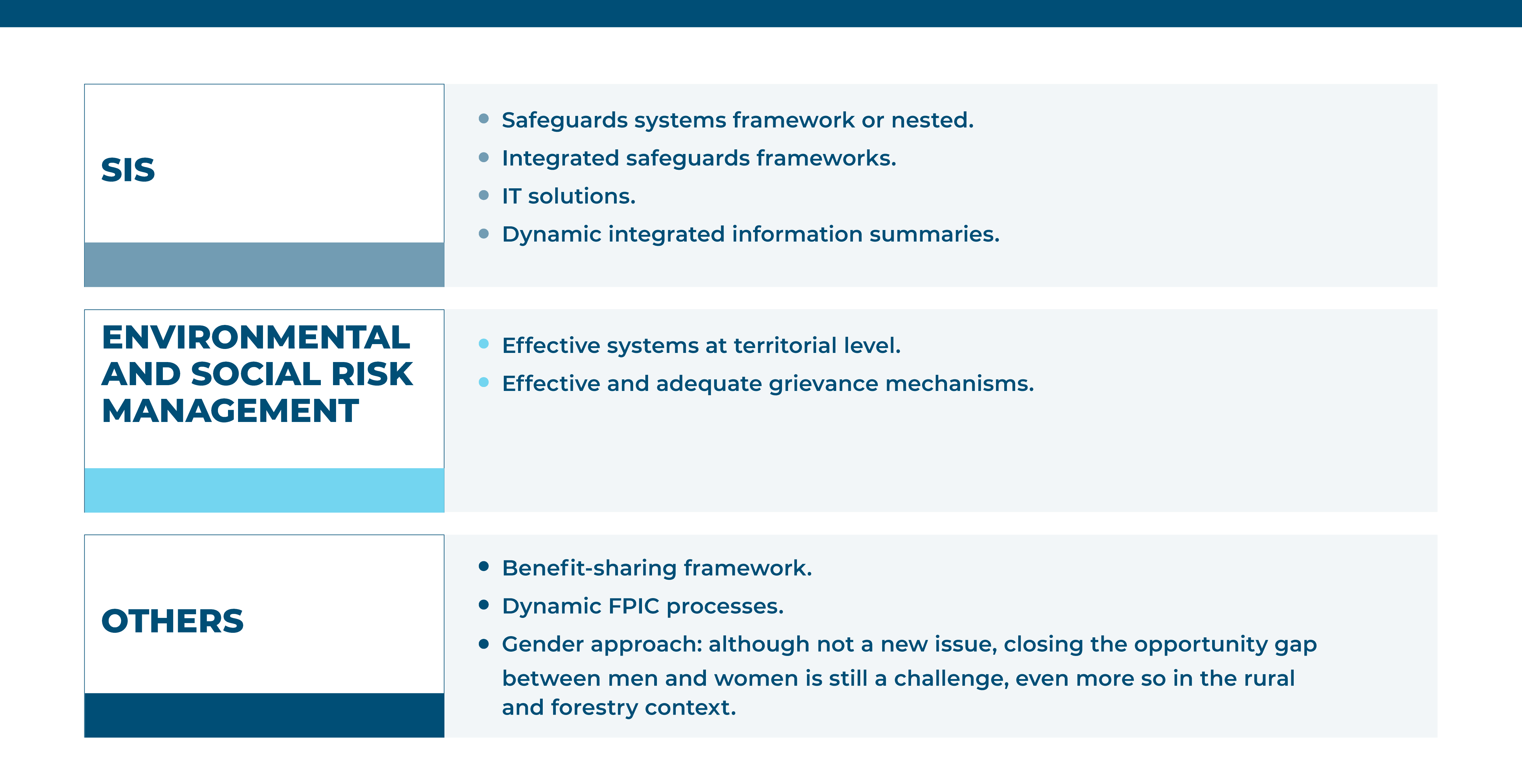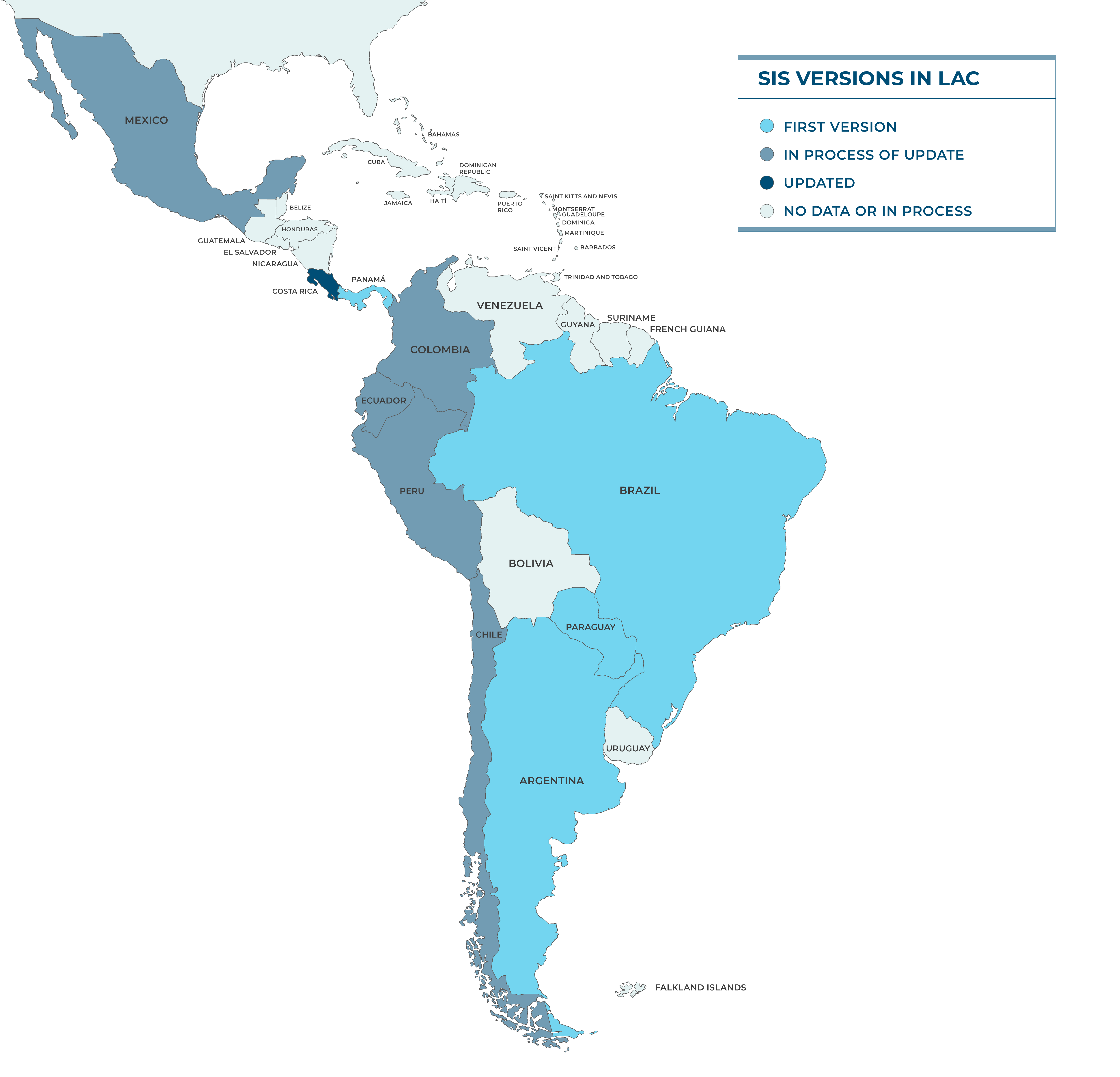The Cancun Agreements of the United Nations Framework Convention on Climate Change (UNFCCC) as one of the framework of safeguards for REDD+ have been in force for more than 14 years. A number of REDD+ countries in the Latin America and the Caribbean (LAC) region have made important advances in their approaches on REDD+ safeguards and have a Safeguards Information System (SIS) in place, in accordance with UNFCCC requirements (see map below), and have sent one (or more) Summaries of Safeguards information to the UNFCCC.
To date, the UN-REDD Programme has accompanied several countries in the region in their process towards understanding and implementing the Cancun Agreements, while also supporting national safeguard teams in their advancement. The Programme also has a strong focus on knowledge management on the subject, such as through the production of reference reports1 and the launching of the UN-REDD Programme's Safeguards and Integrity Working Group for LAC in 2023. In addition, the three UN-REDD agencies (UNDP, UNEP and FAO) act as Accredited Entities of the existing Green Climate Fund (GCF) REDD+ results-based payment (RBP) programmes, which allows for close accompaniment of countries in the implementation of safeguards in practice, and opportunities to exchange information, approaches and approaches on the matter.
Since the Cancun Agreements (COP 12), the Durban Platform (COP 2017) and the Warsaw REDD+ Framework (COP 2019), and other UNFCCC decisions, several countries in the region focused safeguards efforts on meeting UNFCCC requirements, with an emphasis on REDD+ readiness and early steps towards implementation. This included activities such as developing national interpretations of the Cancun Safeguards, understanding the concepts of "addressing" and "respecting", analyzing relevant national and international legal frameworks, designing and implementing SIS, and also contributing to the processes of elaborating the first Safeguards Information Summaries (SoI), among others.
These achievements in safeguards mentioned above were essential for the REDD+ readiness phase. However, now that several countries in the region are in the implementation and results-based payments phases of REDD+, the dynamism of deforestation and forest degradation drivers, technological innovations, and the various market-based approaches and mechanisms, as well as command-and-control measures associated with REDD+, are resulting in new opportunities, challenges and environmental and social risks for the safeguard systems of countries and jurisdictions.
What's new in REDD+ environmental and social management?
With the GCF's RBP projects, countries like Argentina, Brazil, Chile, Colombia and Costa Rica, Ecuador and Paraguay had unprecedented resources to implement their national REDD+ strategies. When implementing these activities in the field, there were occasions where they had to adjust their previous environmental and social management frameworks (ESMF), updating the initially planned risks and mitigation measures. They also had to strengthen safeguards capacities at all levels and implement protocols and processes, such as those for prior consultation, free and informed consent (FPIC) of Indigenous Peoples and Local Communities, gender mainstreaming, grievance mechanisms, and others. As a result, these countries have made notable progress in their risk and benefit management systems, which are adequate to implement and report on safeguards at the level of activities in the territory, and necessary to comply with the high standards of the GCF, which in some aspects considerably raised the levels of requirements in this area.
In line with this last statement, a relevant news item on safeguards, although not strictly related to REDD+, was the recent decision of the GCF Board to suspend the implementation of a restoration project in Nicaragua for non-compliance with its Environmental and Social Safeguards (ESS), especially FPIC requirements. This groundbreaking event, at least for the GCF which is a key player in global REDD+, sent a clear message about what this policy means for the GCF, the challenge and importance of FPIC and the role of grievance mechanisms, among other lessons, which are likely to have caught the attention of the teams of safeguards experts working on the above-mentioned RBP projects.
Safeguards trends
In the framework of the RBP projects, several countries have updated their national SIS, including Chile, Ecuador, Costa Rica, and others are in the process or planning to do so, such as Argentina and Paraguay. In some of these countries, new virtual platforms have been designed, with more automated processes, graphic information, and other resources. Besides, in several of these experiences also coincide in using indicators to report on safeguards respect, a growing trend also observed in other countries, even though it is not a requirement of the UNFCCC. On the other hand, in these processes it is also possible to observe the common challenge of the safeguards teams to resolve how to gather information on safeguards activities in the territory, without building complex systems that are then very costly to operate and maintain.
Another important issue that is attracting the attention of some of the some safeguard teams in the region is how to integrate safeguard information generated by private, public or jurisdictional voluntary carbon market projects (e.g. ART TREES and JNR-Verra) into national SIS, in an integrated and effective way. This implies dialoguing with the safeguard management instruments of the different carbon certification standards, unifying reporting processes, and others new challenges.
To address some of the areas of opportunity outlined above, UN-REDD is accompanying countries in the process of thinking about and designing improvements and adjustments to safeguard systems in areas such as:

Some final thoughts
In this challenging context of REDD+ dynamism and its effective environmental and social management, it is possible to observe an opportunity for putting into practice REDD+ safeguards systems that can serve not only as national reporting systems, but also as effective tools for environmental and social risk management of all REDD+ activities on the ground. These could range from national forest governance policies to private carbon projects, if a country or jurisdiction voluntarily chooses to do so.
While the task is not straightforward, a REDD+ policy with such a safeguards approach could also help with rights compliance and transparency, with a focus on those most in need, along with other issues that are generally of interest to governments' development and/or policy agendas.
Finally, this could also serve for donors and investors as an assurance of high environmental and social integrity of the overall REDD+ strategy, which could result in better opportunities for scaling up finance for forest.

